RV beginners often have many questions about how to care for and protect their RV to keep it in good working order.
And one of the more common questions is: should you cover RV tires in the winter?
It’s recommended to cover RV tires throughout the year including winter, whenever the RV is going to be parked for an extended period of time. As this helps to protect RV tires from sunlight, heat, temperature fluctuations, and moisture.
There’s more to know about covering RV tires than this though, so if you’re considering RV tire covers, make sure to keep reading.
As we provide both the pros and cons of RV tire covers below as well as how to properly install them, other ways to protect your RV tires, and what to look for when purchasing RV tire covers.
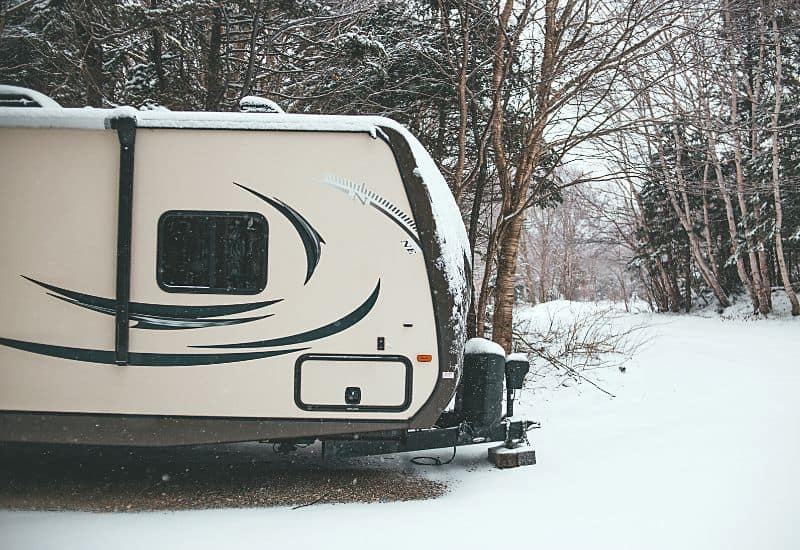
There are several benefits to covering RV tires during the winter, which we’ve outlined below.
Protects Tires From Harmful UV Rays
UV rays or ultraviolet rays, which are produced by the sun, are one of the most harmful elements to tires.
As UV rays can cause cracking, premature aging, and dry rotting on tires, especially on their sidewalls.
Which can compromise tires over time, eventually leading to leaks and even blowouts.
Protects Tires from Extreme Heat
UV rays are not the only thing you need to be concerned about though when it comes to sunlight and RV tires.
As direct sunlight on RV tires can also cause the tires to heat to extreme temperatures, especially when coupled with high ambient temperatures, which can cause the tires to develop heat cracks over time.
Prevents Extreme Temperature Fluctuations
Constant wild temperature fluctuation on tires, which is more common in winter from direct sunlight and cold ambient temperatures can also be harmful to RV tires over time.
As it causes RV tires to constantly expand and contract from the heat of the sun and the cold air, putting unnecessary stress on the tires.
Protects Tires, Rims, and Brakes from Moisture
Another benefit of using RV tire covers during the winter and throughout the year is that it helps to protect RV tires, rims, and brakes from moisture.
Which can cause all sorts of problems like rust, corrosion, and even freezing.
So, if you’re going to be parked in an area where it rains or snows a lot, it’s definitely a good idea to use RV tire covers to help keep your tires and wheels out of the elements and moisture free.
Can RV Tire Covers Damage Your Tires?
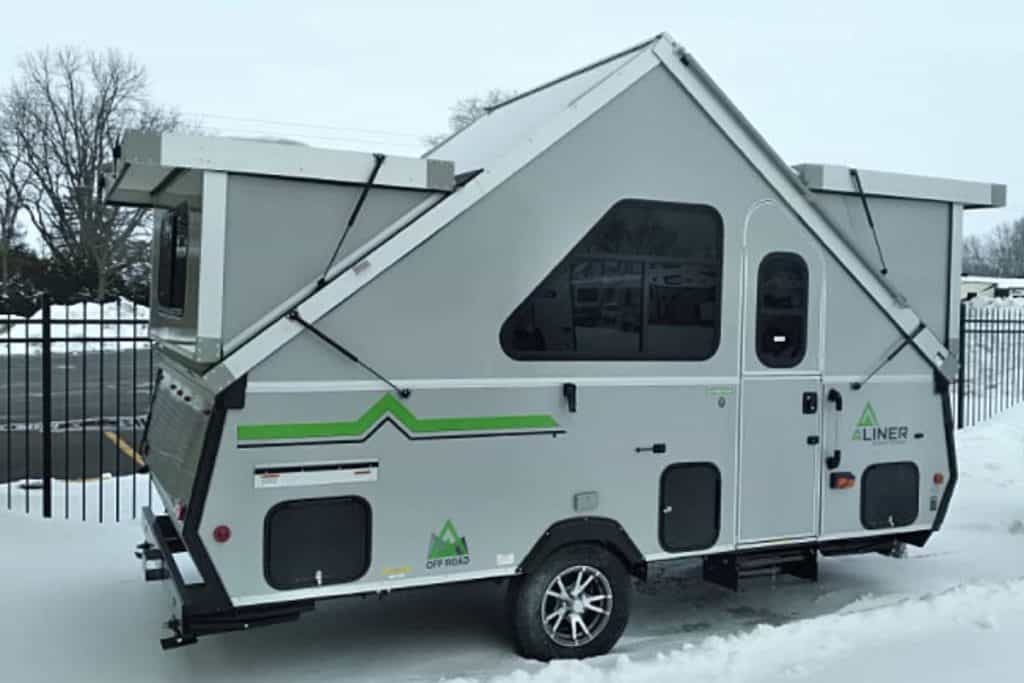
If you’ve been doing any research at all about RV tire covers, then you’ve probably come across information claiming that RV tire covers can somehow damage your tires.
However, when these claims are made they never really give any specifics or examples of how tire covers actually damage tires.
And after extensive research, I’ve found no evidence that tire covers when properly used cause any issues or damage to RV tires.
That’s not to say that they’re aren’t any drawbacks to RV tire covers though.
However, these drawbacks are really more nuisance or hassle related than anything else.
As the biggest drawbacks to using RV tire covers are having to take them off and on and storing them when not in use.
How to Properly Install RV Tire Covers
RV tire covers do a great job of protecting RV tires and wheels.
To receive maximum protection though, it’s important that they’re properly installed.
You might be asking yourself though, how exactly do I properly install RV tire covers?
Here’s what we do that’s worked well over the years.
- Park your RV on dry level ground and chock the wheels.
- Thoroughly clean your RV wheels and tires and ensure they’re free of dirt and grime.
- Make sure the wheels and tires are completely dry before installing the tire covers.
- Use correctly sized tire covers that will properly fit the size of your RV tires.
- Place the tire cover over your RV wheel working from the top down, ensuring that the tire cover is wrapping completely around the entire wheel.
- Make any necessary adjustments to the tire cover, once it’s on, to ensure sure that it’s seated properly and completely covers the wheel.
- Use a drawstring, elastic band, or bungee cord to cinch the cover tight around the tire to ensure it stays in place.
Now, while this might seem like a lot of work, it’s actually pretty quick and easy, once you get the hang of it.
And the effort is more than worth it, considering all the above-mentioned benefits of using RV tire covers.
How to Protect RV Tires in Winter (Beyond Tire Covers)
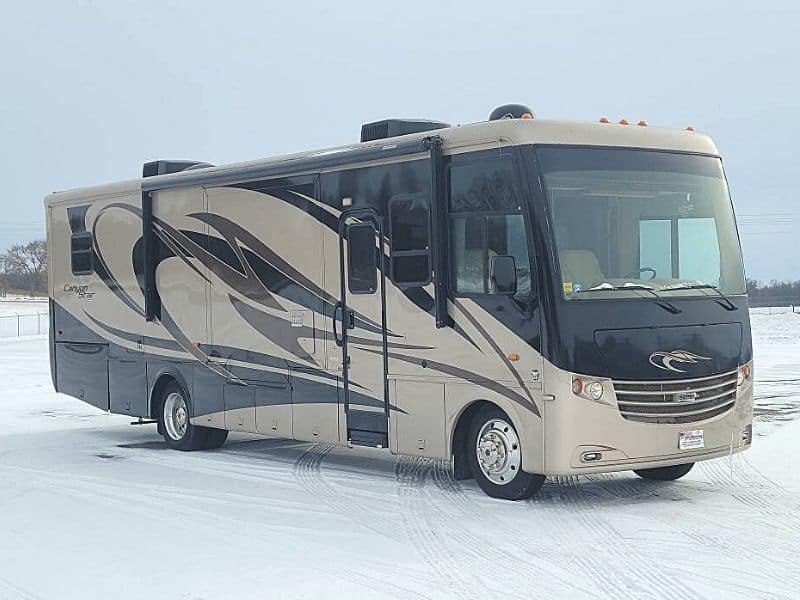
RV tire covers are not the only way you can protect RV tires in the winter.
As there are several other best practices that go a long way in protecting RV tires and extending their useful life, which we’ve outlined below.
Covered or Enclosed RV Storage
One of the best ways to protect your RV and its tires in the winter (or any time of year for that matter) is to store your RV in a covered or enclosed storage facility.
As this will help to protect your RV from the elements, including sun, rain, snow, and even hail.
And while this might not be an option for everyone, due to cost considerations.
If you have the opportunity and the budget, it’s definitely worth taking advantage of.
Throurouglty Wash and Clean the Tires and Condition the Rubber
One of the best things you can do for RV tires is to wash and clean them periodically.
And this is especially true if you plan on storing the RV for an extended period of time, such as winter.
As you want to ensure that the tires are free of any dirt, grime, or other contaminants before storing.
In addition, you should also consider applying a coat of protectant or tire dressing to the tires, such as this popular option from Amazon, after they’re clean, to condition and hydrate the rubber.
To help prevent the tires from drying out or dry rotting.
Park the RV on Boards Off the Ground
If you’re going to be storing your RV outside, even if it’s just for a short period of time, you should consider parking the RV on boards to keep the tires off the ground.
As they will provide a barrier between your RV tires and the ground.
Which can help to keep moisture away from the tires from rain, snow, or mud.
Periodically Move the RV Slightly Forward or Backward
If you’re storing your RV for an extended period of time (more than a month).
It’s a good idea to periodically move the RV slightly forward or backward to help keep the tires from developing flat spots.
As the weight of the RV sitting in one spot for too long can cause the tires to develop flat spots.
Which can eventually become permanent and ruin the tires, if the RV is left for a long enough period without being moved.
Ensure Your RV Tires are Properly Inflated and Consider Moderate Overinflation
Ensuring that your RV tires are properly inflated to the correct PSI is always important but it’s even more critical if you’re storing the RV for an extended period of time.
As underinflated tires can put more strain on the sidewalls, which can lead to cracking and cause the tire to develop flat spots more quickly.
In fact, if you’re planning on storing the RV for an extended period of time and you’re not planning to periodically check the RVs tire pressure, you might even want to consider reasonable or moderate overinflation.
As this will help to keep your tire from being dangerously underinflated for a long period of time, potentially leading to the problems mentioned above.
Empty the RV and Reduce the Weight on the Tires
If you’re able to, it’s always best to empty the RV when storing long-term, to reduce the weight on the tires as much as possible.
As this will help to reduce the amount of strain on the tires. Which can lead to premature wear and tear on the tires and an increased likelihood of flat spots.
If you have to store the RV with items inside though, try to keep the weight to a minimum and make sure to evenly distribute the weight throughout the RV.
Consider Lifting the RV Tires Off the Ground for Long-Term Storage
While definitely not necessary if you’re only going to be storing the RV for a few months in the winter, if you’re planning on storing an RV for a year or more, you might want to consider lifting the RV tires off the ground and potentially even removing them, to help prolong the life of the tires.
As this will eliminate the issue of flat spots.
And help to keep the tires from being exposed to moisture and the elements like snow, rain, or mud.
If you do plan to go this route though, it’s important to lift the RV properly and make sure that it is fully and safely supported, to prevent injury and even death from the RV shifting or falling while it’s lifted or elevated off the ground.
Best RV Tire Covers for Winter
Explore Land Tire Covers 4 Pack
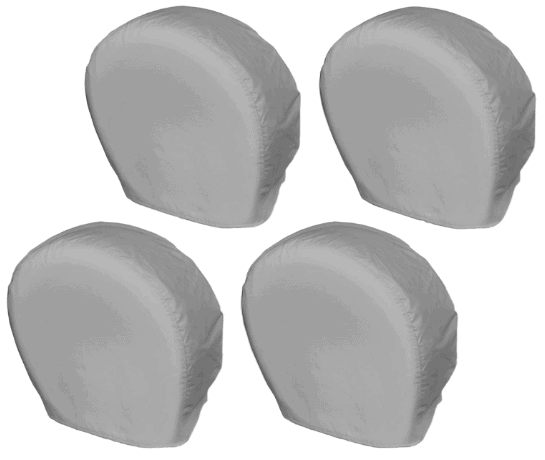
- All Season Covers
- Snow, Rain, and Wind Proof
- Durable Water Resistant Coating with UV Stabilized Treatment
- Elastic Cord with Auto-Lock Design Provide Snug Wind Resistant Fit
- 3 Year Warranty
Kayme RV Tire Covers Set of 4
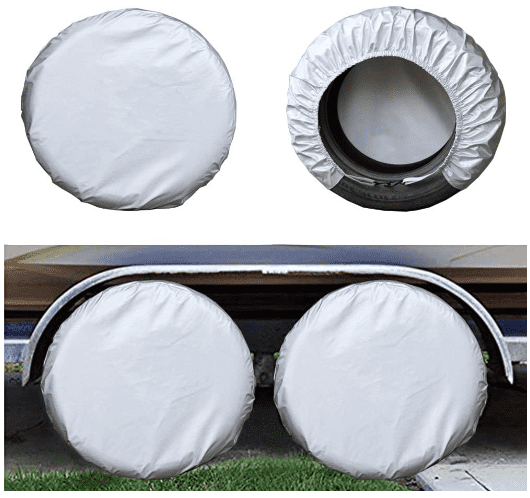
- 100% Waterproof (Great for Snowproofing and Rainproofing)
- Made From Four Layers of Heavy-Duty Premium Material
- Tear and Scratch Resistant Even in Cold Climates
- Full Elastic Band Provides Snug Fit
- Soft Cotton Inner Lining
Leader Accessories 4-Pack Tire Covers
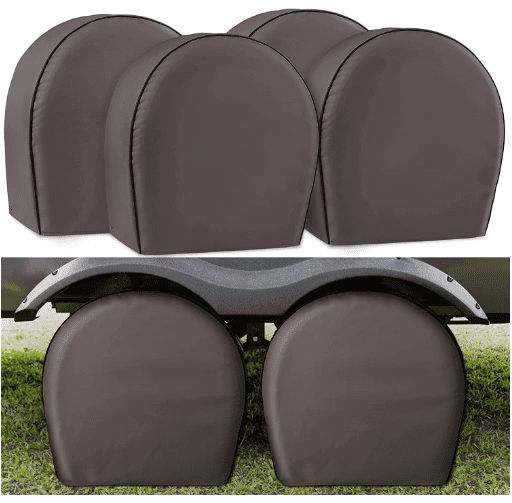
- Made from Premium Heavy-Duty Waterproof Material (600D Oxford)
- High and Low-Temperature Resistance to Protect Wheels in All Seasons
- Offers Better Tensile Strength and Flexibility Compared to Vinyl Tire Covers
- Easy Installation
- Snug Fit with Elasticized Back Hem
- Built-In Eyelet with Bungee Cord Provides More Secure Fit
- 3 Year Warranty
What to Look for When Choosing RV Tire Covers for Winter
When choosing RV tire covers for winter there are several key things you want to look for to ensure they provide the most protection.
- Made From Heavy Duty Waterproof Material: You want the tire cover to be made from heavy-duty waterproof material to ensure that it keeps moisture away from the rim and tire.
- High and Low-Temperature Resistance: You also want the tire cover to have high and low-temperature resistance. As this will keep the tire cover from cracking or tearing in extreme cold.
- Easy Installation: Another important consideration is to make sure the tire cover is easy to get on and off.
- Appropriately Sized and a Snug Fit: Tire covers come in a variety of sizes. So make sure you pick the right size cover for your RV tire, to ensure a snug fit.
- Elastic Hem or Built-In Bungee Cord: The last thing you want to make sure the tire cover has is either an elastic hem or a built-in bungee cord. As this will help to keep the tire cover in place and ensure that it doesn’t blow off.
Final Thoughts
If you plan to store your RV for any extended period of time, it’s best practice to cover your RV tires with tire covers.
As this protects the tires from harmful UV rays, extreme heat, drastic temperature fluctuations, and moisture.
Which not only helps to keep you and your family safe while on the road, by reducing the likelihood of a tire failure or a blowout.
But it also saves you money, as taking care of RV tires can extend their useful life.
Which is a good thing, considering that the average travel trailer tire costs $164, and the average motorhome tire costs $275.
Additional RV Care Resources
Are RV Covers a Good Idea? Everything You Need to Know
Recent Posts
When cruising down the highway in your RV, the last thing you want is a tire blowout! Not only is it dangerous, but RV tire replacement isn't cheap, costing $200 to $300 per tire. The good news,...
Nothing ruins an RV adventure faster than a breakdown with no way to fix it. Because of this, every RVer should have a well-stocked RV tool kit for those unexpected roadside emergencies and campsite...

